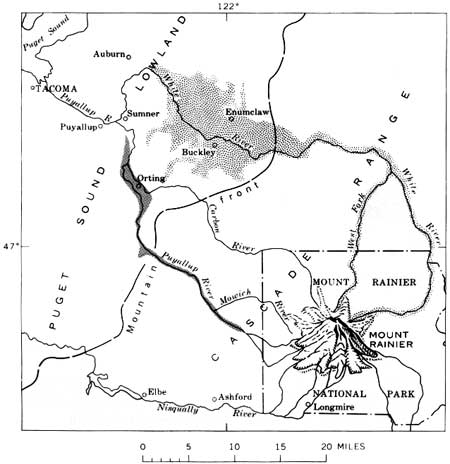
|
Geological Survey Bulletin 1238
Volcanic Hazards at Mount Rainier, Washington |
INTRODUCTION
VOLCANIC HAZARDS
at mount rainier, washington
Mount Rainier is a large stratovolcano of andesitic rock in the Cascade Range of western Washington (fig. 1). Although the volcano as it now stands was almost completely formed before the last major glaciation, geologic formations record a variety of events that have occurred at the volcano in postglacial time. Repetition of some of these events today without warning would result in property damage and loss of life on a catastrophic scale. It is appropriate, therefore, to examine the extent, frequency, and apparent origin of these phenomena and to attempt to predict the effects on man of similar events in the future.
The present report was prompted by a contrast that we noted during a study of surficial geologic deposits in Mount Rainier National Park, between the present tranquil landscape adjacent to the volcano and the violent events that shaped parts of that same landscape in the recent past.
Natural catastrophes that have geologic causes—such as eruptions, landslides, earthquakes, and floods—all too often are disastrous primarily because man has not understood and made allowance for the geologic environment he occupies. Assessment of the potential hazards of a volcanic environment is especially difficult, for prediction of the time and kind of volcanic activity is still an imperfect art, even at active volcanoes whose behavior has been closely observed for many years. Qualified predictions, however, can be used to plan ways in which hazards to life and property can be minimized.
The prediction of eruptions is handicapped because volcanism results from conditions far beneath the surface of the earth, where the causative factors cannot be seen and, for the most part, cannot be measured. Consequently, long-range predictions at Mount Rainier can be based only on the past behavior of the volcano, as revealed by study of the deposits that resulted from previous eruptions. Predictions of this sort, of course, cannot be specific as to time and locale of future events, and clearly are valid only if the past behavior is, as we believe, a reliable guide.

The purpose of this report is to infer the events recorded by certain postglacial deposits at Mount Rainier and to suggest what bearing similar events in the future might have on land use within and near the park. In addition, table 2 (page 22) gives possible warning signs of an impending eruption. We want to increase man's understanding of a possibly hazardous geologic environment around Mount Rainier volcano, yet we do not wish to imply for certain that the hazards described are either immediate or inevitable. However, we do believe that hazards exist, that some caution is warranted, and that some major hazards can be avoided by judicious planning.
Most of the events with which we are concerned are sporadic phenomena that have resulted directly or indirectly from volcanic eruptions. Although no eruptions (other than steam emission) of the volcano in historic time are unequivocally known (Hopson and others, 1962), pyroclastic (air-laid) deposits of pumice and rock debris attest to repeated, widely spaced eruptions during the 10,000 years or so of postglacial time. In addition, the constituents of some debris flows1 indicate an origin during eruptions of molten rock; other debris flows, because of their large size and constituents, are believed to have been caused by steam explosions. Some debris flows, however, are not related to volcanism at all.
1A debris flow is a mixture of rock debris and water which moves rapidly as a mass and owes its mobility to the included water. A mud flow is a variety of debris flow in which the solid component is composed of at least 50 percent sand, silt, and clay (Varnes, 1958).
| <<< Previous | <<< Contents >>> | Next >>> |
bul/1238/intro.htm
Last Updated: 28-Mar-2006
